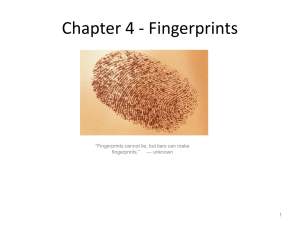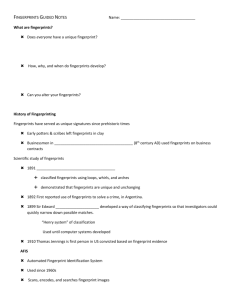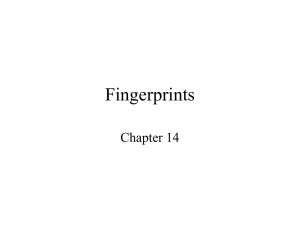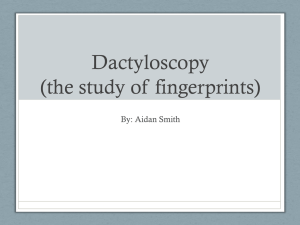FSP 07 Fingerprinting - Centre for Learning Technology
advertisement
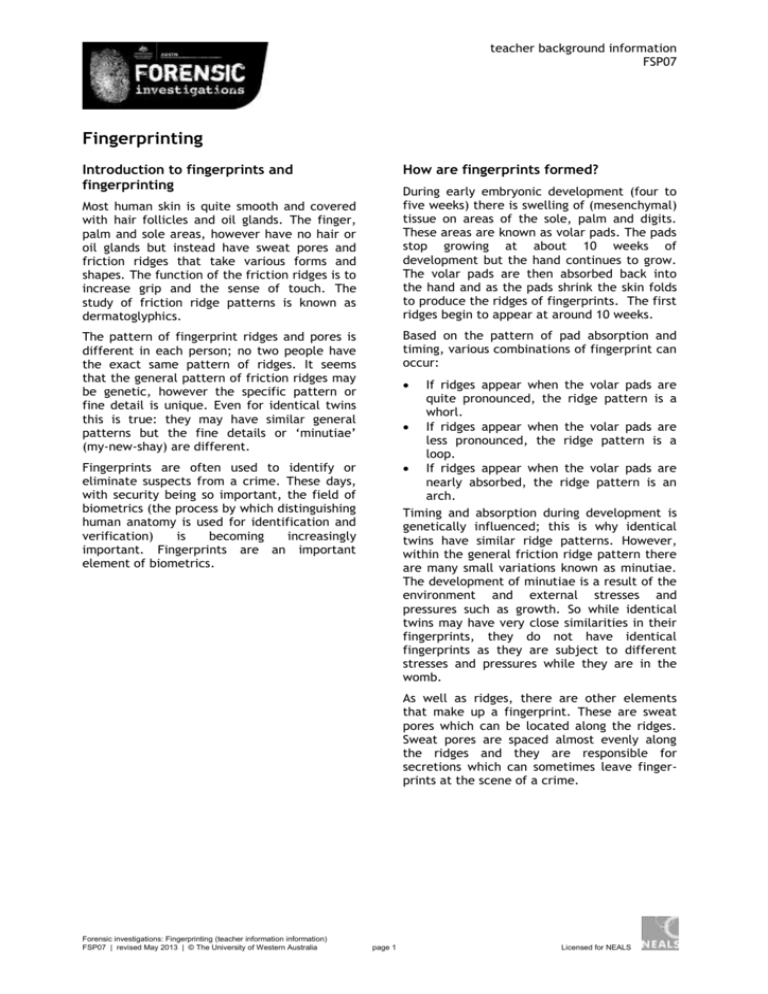
teacher background information FSP07 Fingerprinting Introduction to fingerprints and fingerprinting How are fingerprints formed? During early embryonic development (four to five weeks) there is swelling of (mesenchymal) tissue on areas of the sole, palm and digits. These areas are known as volar pads. The pads stop growing at about 10 weeks of development but the hand continues to grow. The volar pads are then absorbed back into the hand and as the pads shrink the skin folds to produce the ridges of fingerprints. The first ridges begin to appear at around 10 weeks. Most human skin is quite smooth and covered with hair follicles and oil glands. The finger, palm and sole areas, however have no hair or oil glands but instead have sweat pores and friction ridges that take various forms and shapes. The function of the friction ridges is to increase grip and the sense of touch. The study of friction ridge patterns is known as dermatoglyphics. Based on the pattern of pad absorption and timing, various combinations of fingerprint can occur: The pattern of fingerprint ridges and pores is different in each person; no two people have the exact same pattern of ridges. It seems that the general pattern of friction ridges may be genetic, however the specific pattern or fine detail is unique. Even for identical twins this is true: they may have similar general patterns but the fine details or ‘minutiae’ (my-new-shay) are different. If ridges appear when the volar pads are quite pronounced, the ridge pattern is a whorl. If ridges appear when the volar pads are less pronounced, the ridge pattern is a loop. If ridges appear when the volar pads are nearly absorbed, the ridge pattern is an arch. Timing and absorption during development is genetically influenced; this is why identical twins have similar ridge patterns. However, within the general friction ridge pattern there are many small variations known as minutiae. The development of minutiae is a result of the environment and external stresses and pressures such as growth. So while identical twins may have very close similarities in their fingerprints, they do not have identical fingerprints as they are subject to different stresses and pressures while they are in the womb. Fingerprints are often used to identify or eliminate suspects from a crime. These days, with security being so important, the field of biometrics (the process by which distinguishing human anatomy is used for identification and verification) is becoming increasingly important. Fingerprints are an important element of biometrics. As well as ridges, there are other elements that make up a fingerprint. These are sweat pores which can be located along the ridges. Sweat pores are spaced almost evenly along the ridges and they are responsible for secretions which can sometimes leave fingerprints at the scene of a crime. Forensic investigations: Fingerprinting (teacher information information) FSP07 | revised May 2013 | © The University of Western Australia page 1 Licensed for NEALS What is a fingerprint? First major case in the US Fingerprints are the marks left behind when someone touches an object with their finger. There are three types of fingerprints that can be left behind. United States 1911. People vs Jennings The first case in the US that involved fingerprints as evidence was that of Thomas Jennings. He was convicted of murder of Mr Hiller, the owner of a home that Jennings illegally entered. 1. An impression left in something soft (such as butter, putty, soap or wet paint) 2. A print left by a finger that is covered in something that is left behind such as dirt, blood, paint or ink. 3. An invisible deposit left by secretions from the skin. Everyone’s fingers have small amounts of oil and perspiration which come out of microscopic pores on the tiny ridges of the fingerprints. These secretions also come out of different parts of the body too. Clarence Hiller always left a gas-light burning at the head of the stairs near the door leading to his daughter’s room. Shortly after 2am on a Monday morning Mrs Hiller woke and noticed that the light was out and roused Mr Hiller. Hiller got up and encountered an intruder at the head of the stairs. They struggled and both fell which eventuated in Hiller being shot twice. Hiller died from the gunshot wounds. Hiller’s house had recently been painted. The back veranda had been painted two days earlier, on Saturday. Jennings entered the house through a rear window in the kitchen, which was close to the back veranda railing. During the investigation of the crime scene, police found the imprint of four fingers of a left hand (which were recorded in the fresh paint on the railing). The police removed the railing so that it could be used as evidence. Enlarged photographs of the prints were made. Why are fingerprints used in forensics? There are three basic principles about why forensics scientists use fingerprints as evidence: 1. After almost a century of fingerprint existence, no two fingers have ever been found to possess identical ridge characteristics. 2. A fingerprint remains unchanged during a persons’ lifetime. (Unless they are involved in a accident which affects their hands.) 3. Fingerprints have ridge characteristics that allow for efficient classification and examination. Jennings was arrested after several eyewitnesses identified him. A coincidence during this case was that he had earlier had been fingerprinted during a stint in prison in 1910. Jennings was again fingerprinted after his arrest and when compared, the prints produced a match. History The defendant argued that the evidence of the comparison of his fingerprints to those found on the railing was improperly admitted. The accuracy of the photographs, the analysis method, the taking of fingerprints or the correctness of the photographic enlargement was not questioned in court. The FBI Identification Division started in 1924 with 8 million fingerprint files. Many of the fingerprints were taken from criminals in Leavenworth Prison. By 2001 the FBI in the United States had well over 250 million records from both criminals and civilians. Civilian prints were taken from government employees and applicants for federal jobs. Forensic investigations: Fingerprinting (teacher information information) FSP07 | revised May 2013 | © The University of Western Australia Various witnesses for the prosecution testified about their expertise in regard to fingerprints. This case established that there was a scientific basis for the system of fingerprint identification and that expert witnesses were qualified to testify. Thomas Jennings was sentenced to death and executed on February 16, 1912 for the murder of Clarence B Hiller. page 2 Fingerprint classification Whorls There are three main structures that make up fingerprints. These are loops, whorls and arches. Whorls have a circular pattern and have at least two deltas and a core. Whorls look a little like target shapes or whirlpools – circles within circles. Whorls make up 35% of patterns seen in human fingerprints and can be subgrouped into four categories: Loops Loops are comprised of one or more ridges entering from one side, curving, and then going out the same side it entered. The ridges in loops double back on themselves. All loops have elements called a delta and a core. The delta is a triangular area usually shaped like a T-junction, while a core is the centre of the pattern. About 65% of fingerprints have loops. Loops can be divided into two groups: Radial loops – these flow downward and toward the radius (or the thumb side) Ulnar loops – which flow toward the ulnar (or the little finger side). The ulnar loop is more common. Plain whorls – which are either concentric circles like a bull’s eye or spirals like a wound spring. Central pocket loop whorls – these resemble a loop with a whorl at its end. Double loop whorls – these occur when two loops collide to produce an ‘S’-shaped pattern. Accidental loop whorls – these are slightly different from other whorls and are irregular. Arches Arches are the least common pattern making up only 5% of all pattern types. Arches are ridgelines that rise in the centre and create a wave like pattern. The ridges enter from one side and exit the other side with a rise in the middle. They do not have a delta or a core and can be broken into two sub-groups: NOTE: you need to know which hand (right or left) made the print before your can tell if it is an ulnar or a radial loop. Forensic investigations: Fingerprinting (teacher information information) FSP07 | revised May 2013 | © The University of Western Australia page 3 Plain arch – which has a gentle rise. Tented arches - have a steeper rise than plain arches. The finer structures that make up fingerprints are called minutiae. There are several types of minutiae – these are displayed in the table below. The dots found in the structures below represent the pores on the ridges where sweat is secreted. Latent, patent or plastic prints There are three general types of fingerprints that can be left behind at a crime scene. These types depend on how and where the fingerprints were left. Some fingerprints are easier to find than others. For example, a print left in wet paint or on a greasy wall is easier to find than one left with quite clean hands on a garbage bag. Fine structures – Minutiae (‘min-oo-shay’) delta These are the three types of prints forensic scientists are likely to find: ridge ending Latent prints are invisible and cannot be seen without special lighting or processing. In latent fingerprints, the ridge structure is reproduced on an object in sweat, or other substances naturally present (or added there by accident) on the fingers. Although there are no oil secretions from the fingers themselves we often have oils on our hands from touching our hair and face and this oil is enough to leave a print. Patent prints are visible and occur when substances such as blood, ink, paint, grease or dirt on the fingers of the perpetrator leave behind an easily seen print. Visible or patent prints are visible without any particular treatment Plastic prints have a three-dimensional quality and occur when the finger is pressed into something that leaves an indentation or impression print. Soft substances that patent prints may occur in include wax, putty, soap, cold butter and dust. bifurcation dot or island hook lake bridge An example of identifying minutiae in a fingerprint is in the labelled picture below. Simple detection techniques used for developing fingerprinting latent prints There are two main ways that latent prints can be detected; powders and chemical fuming. Powders and dusting Powders are used for detecting latent marks on non-porous surfaces such as glass, plastic, metal surfaces, glazed tiles and glossy paint. The fine powder attaches to any greasy/oily substances in the fingerprint deposit. Powdering is only effective on quite fresh marks as the mark dries out over time and looses its stickiness. Black power (made from carbon black or charcoal) and grey powder (made from aluminium or titanium powder) Forensic investigations: Fingerprinting (teacher information information) FSP07 | revised May 2013 | © The University of Western Australia page 4 are used most often. Police who dust at a scene will use a powder that contrasts with the object colour they are dusting on so that prints are easier to see. Once the fingerprint has been dusted, the latent impressions are preserved as evidence either by photography or by lifting powdered prints using special sticky tape. This is done in a fuming chamber and when the iodine vapour combines with oils in the latent print a brownish print is produced. This sort of print does fade quickly though, so photographs must be taken straight away or it must be fixed by spraying the print with a solution of starch and water. The starch and water will preserve the print for several weeks or months. If you wish to try dusting with your students you will find that cocoa powder or talcum powder work well. Fine powders work best. 3. Ninhydrin. Ninhydrin (triketohydridene hydrate) has been used for years to reveal latent prints and it is an important and regularly used technique today. The evidence that the latent print is meant to be on is dipped in or sprayed with ninhydrin solution. This solution reacts with the oils and proteins in the print. This process is extremely slow and it may take several hours for the print to appear as a purple-blue colour. Heating the object to around 26 to 38° C will speed up the process. Chemical fuming: using chemistry to expose prints Latent prints can also be developed using chemicals to expose prints. This is called chemical fuming. Chemical fuming is when the surface with suspected prints is exposed to chemical fumes. When fingerprints are difficult to see or if forensic scientists are not sure if fingerprints are present, they use this technique to ‘process’ fingerprints and make them visible. Ninhydrin is used on porous surfaces such as paper, cardboard, fabrics and untreated wood. As protein molecules are quite stable, old latent marks and prints can be developed with ninhydrin. 1. Cyanoacrylate vapour. More commonly known by its trade name – Super Glue (which is 98% cyanoacrylate). This is an extremely useful forensic tool. When heated and mixed with sodium hydroxide (another common household chemical), cyanoacrylate releases vapours that bind to amino acids. There are amino acids present in print residue, so voila, when they bind a hard, white latent print is left behind. The print can then be photographed as is, or treated with a florescent dye that will make the print glow under UV light. 4. Silver nitrate. Silver nitrate is a component that is used in black and white photographic film. This process works to produce a black or reddish brown print when viewed under ultra violet (UV) light. Sweat is often a component found in latent prints. Sweat contains salts, one of which is sodium chloride (like the salt you put on your dinner). When investigators expose the latent print to silver nitrate, the chloride in the salt reacts with the silver nitrate to form a new compound called silver chloride. This colourless compound will develop and become visible when exposed to UV light. The evidence that is to be checked for fingerprints is often exposed to the vapour in something called a fuming chamber. This can be done at the crime scene in a fuming box, but these days police frequently use hand held wands. These gadgets heat a small cartridge of cyanoacrylate mixed with florescent dye which can be directed at latent prints at a crime scene. When prints react with the cyanoacrylate, they are also fixed at the same time with florescent dye making the process much faster and easier. Super Glue vapour works well on surfaces such as glass, plastics and metal objects 2. Iodine fuming. When heated the solid crystals of iodine release iodine vapours. Forensic investigations: Fingerprinting (teacher information information) FSP07 | revised May 2013 | © The University of Western Australia page 5 Analysis of fingerprints Interesting Information The assessor must determine if the recovered fingerprint is clear enough to enable a full analysis. If so, there are three steps that the scientists must follow to be able to accurately assess the print. The print is always photographed. It is possible to collect DNA from non-blood latent fingerprints. Skin cells are continuously being shed and can be deposited in a fingerprint. There a many more techniques used to detect latent fingerprints. Among them are: vacuum metal deposition, small particle reagent, gentian violet and use of luminescence and fluorescence. Step 1 – does not require magnification Assess the overall pattern of the friction ridges. Whorl, loop or arch. Latent fingerprints can be detected on human skin. It is however a very difficult surface to get prints off mainly because the same secretory compounds that are in the fingerprints are also naturally on the skin. If a print is less than a few hours old it can be possible. Step 2 – requires x5 to x10 magnification Major ridge pattern deviations or minutiae or points of identification are established: ridge endings, bifurcations and dots (and variations of these basic patterns). Features such as scars, creases etc are also included. All primates also have friction ridges on their hands and feet. Some new world monkeys also have friction ridges on their tails. Step 3 – higher magnification Details such as the alignment or shape of ridges, pore shape and position. Fingerprints are then compared between the unknown mark (the fingerprint found at the scene) and a known print (a print found in police records or collected from a suspect). Cleaning up the print using digital techniques More often than not a print or a partial print found at the scene of a crime is unclear. It is uncommon to get a perfect print! The minute details of a print may be fuzzy, missing or difficult to see. With the development of digital technology, the problems with fingerprints can be solved more easily than before. Prints can be scanned into a computer and then transferred into one of many computer programs. These programs can enhance, improve, and clean up the computer generated image of the print. By changing the light, clarity, contrast and background patterns electronically, certain details of the print can become more obvious giving the investigators more clues than previously available, providing more accurate evidence and also speeding up the matching process. Forensic investigations: Fingerprinting (teacher information information) FSP07 | revised May 2013 | © The University of Western Australia page 6





